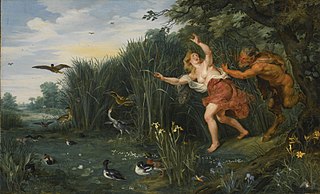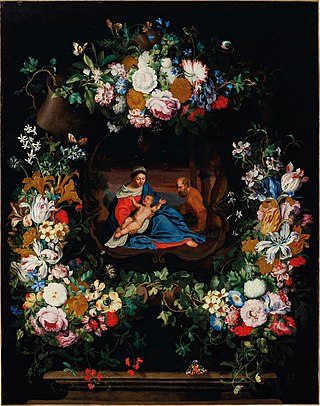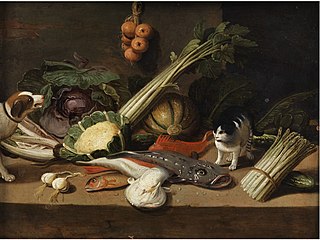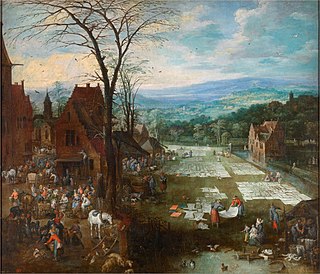Related Research Articles

Pieter Brueghelthe Younger was a Flemish painter known for numerous copies after his father Pieter Bruegel the Elder's work, as well as original compositions and Bruegelian pastiches. The large output of his studio, which produced for the local and export market, contributed to the international spread of his father's imagery.

Pieter Bruegelthe Elder was among the most significant artists of Dutch and Flemish Renaissance painting, a painter and printmaker, known for his landscapes and peasant scenes ; he was a pioneer in presenting both types of subject as large paintings.

Jan Brueghelthe Elder was a Flemish painter and draughtsman. He was the son of the eminent Flemish Renaissance painter Pieter Bruegel the Elder. A close friend and frequent collaborator with Peter Paul Rubens, the two artists were the leading Flemish painters in the first three decades of the 17th century.

Jan Brueghelthe Younger was a Flemish Baroque painter. He was the son of Jan Brueghel the Elder, and grandson of Pieter Bruegel the Elder, both prominent painters who contributed respectively to the development of Renaissance and Baroque painting in the Habsburg Netherlands. Taking over his father's workshop at an early age, he largely painted the same subjects as his father in a style which was similar to that of his father. He gradually was able to break away from his father's style by developing a broader, more painterly, and less structured manner of painting. He regularly collaborated with leading Flemish painters of his time.

Jan van Kessel the Younger or Jan van Kessel II, known in Spain as Juan Vanchesel el Mozo or el Joven, was a Flemish painter who after training in Antwerp worked in Spain. Known mainly for his portraits he became a court painter to the King and Queen of Spain. A few landscapes and mythological and allegorical scenes have also been attributed to him. He was formerly believed to have been active as a landscape painter, but this is now no longer generally accepted.

Joos de Momper the Younger or Joost de Momper the Younger was a Flemish landscape painter active in Antwerp between the late 16th century and the early 17th century. Brueghel's influence is clearly evident in many of de Momper's paintings. His work is situated at the transition from late 16th-century Mannerism to the greater realism in landscape painting that developed in the early 17th century. He achieved considerable success during his lifetime.

Ambrosius Brueghel was a Flemish painter from the famous Brueghel family of artists. Less prolific and less well-known than a number of his family members, his oeuvre is not very well understood and is believed to comprise Baroque still lifes, garland paintings as well as landscapes.

Marten van Cleve the Elder was a Flemish painter and draftsman active in Antwerp between 1551 and 1581. Van Cleve is mainly known for his genre scenes with peasants and landscapes, which show a certain resemblance with the work of Pieter Bruegel the Elder. Marten van Cleve was one of the leading Flemish artists of his generation. His subjects and compositions were an important influence on the work of Pieter Brueghel the Younger and other genre painters of his generation.

Jan Pieter Brueghel or Jan Peeter Brueghel was a Flemish painter who specialised in flower still lifes and garland paintings. A scion of the famous Brueghel family of painters, he trained in Antwerp with his father and later worked in Liège, Paris and Italy.

Pseudo-Jan van Kessel the Younger or Pseudo-Jan van Kessel the (II) is the notname given to an artist or workshop to whom or which are attributed about 200 small still lifes likely dating to the late 16th and early 17th century. The artist's works rely on combinations of a limited number of motifs in rather simple to quite elaborate compositions. The motifs in the paintings are rendered in a rather naive and decorative manner. While the Flemish influence in the works hints at a Flemish artist or an artist who trained with a Flemish artist, the artist is believed to have been active in southern Europe, probably Italy.
Carl Adolf Rosenberg was a German theater critic and art historian.

Winter Landscape with Ice-skaters and Bird-trap is a 1565 painting attributed to the Flemish painter Pieter Bruegel the Elder, located in the Royal Museums of Fine Arts of Belgium in Brussels. It shows a village scene where people skate on a frozen river, while on the right among trees and bushes, birds gather around a bird trap. It has become known as the original or oldest exemplar of the most successful painting of the Brueghel family dynasty, since the art historian Klaus Ertz documented 127 copies in his comprehensive monograph on the artist's son in 2000.

The Brueghel family, also spelled Bruegel or Breughel, is an extended family of Dutch and Flemish painters which played a major role in the development of the art in Brabant and Flanders throughout the 16th and 17th centuries. Due to the organisation in guilds and training being done with established painters and not in schools or academies, painters often passed on the knowledge from father to son, and there are many examples of Flemish painting families spanning two or more generations, e.g. the Francken family, which had at least ten painters spanning four generations. The Brueghel family produced the largest number of major painters of all Flemish families.

Flemish Market and Washing Place is an oil-on-canvas painting by Flemish painter Joos de Momper. It was painted in the 1620s, and it might be a collaboration between de Momper and Jan Brueghel the Elder

Landscape with Sea and Mountain is an oil-on-canvas painting by Flemish painter Joos de Momper. It was painted in the early 1620s, and is now in the Museum of Prado in Madrid.

Excursion in the Countryside of Infanta Isabel Clara Eugenia is an oil on canvas painting by Flemish artists Jan Brueghel the Elder and Joos de Momper. It was painted in the first quarter of the 17th century, and is housed at the Museum of Prado, in Madrid.

The Infanta Isabel Clara Eugenia in the Mariemont Park is a large oil on canvas painting by Flemish artists Jan Brueghel the Elder and Joos de Momper. It was painted in the first quarter of the 17th century. The painting is kept in the Museum of Prado in Madrid.

Summer Landscape with Harvesters is an oil-on-canvas painting by Flemish artists Joos de Momper and Jan Brueghel the Elder. It was painted in the first quarter of the 17th century, probably around 1610, and is currently housed at the Museum of Art in Toledo, Ohio. After having been exposed in Toledo as an "anonymous loan," the Museum directory opted for the purchase, influenced by the reaction of the public. The painting was acquired by the Toledo Museum of Art in 2003.

Grotto Landscape with a Hermitage, also called The Reading Hermit, is an oil on canvas painting by Flemish painters Jan Brueghel the Younger and Joos de Momper. It was painted around 1625, and is currently in private collection. It depicts a reading hermit in a monumental grotto, several pilgrims and various animals. It was painted in Antwerp.
References
- works by Klaus Ertz on WorldCat
- works by Klaus Ertz in RKD
- works by Klaus Ertz in collaborative research website "janbrueghel.net"